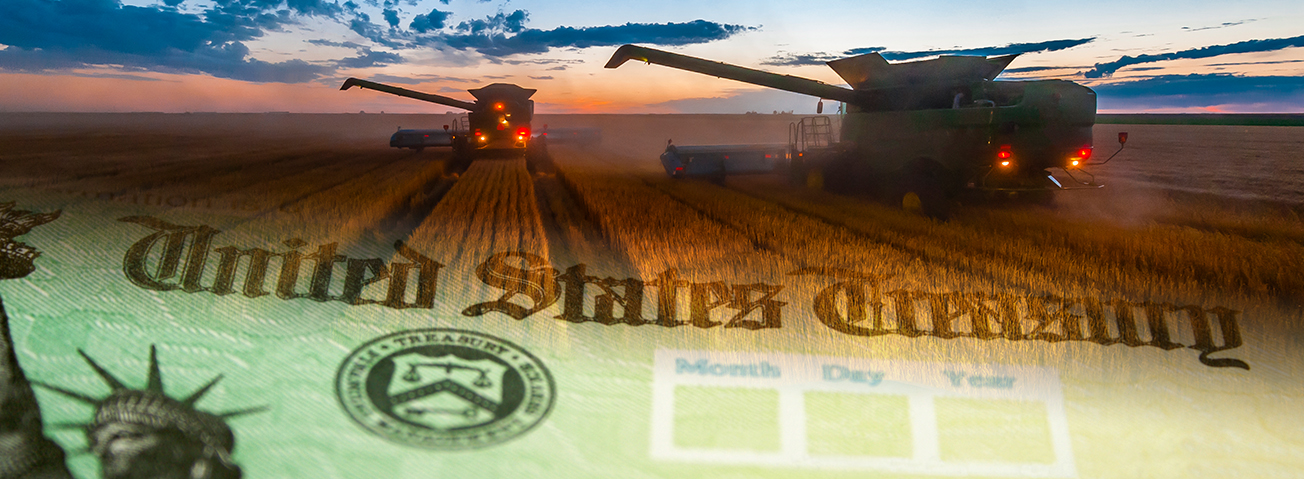
Commercial Farms Received the Most Government Payments in 2019
- by Dipak Subedi, Anil K. Giri and Tia M. McDonald
- 7/6/2021
Multiple USDA programs disburse payments to farm operations each year. Payments to farm operators totaled $14.8 billion in 2019, based on data from USDA’s Agricultural Resource Management Survey. More than 30 percent of about 1.97 million U.S. farms received some government program-related payments that year, with an average payment of $24,623.
The distribution of payments varied by farm type, which USDA’s Economic Research Service defines based on gross cash farm income (GCFI) and operator type. About 74 percent of commercial farms received government payments in 2019, with an average payment of $84,775. Commercial farms are defined by ERS as making $350,000 or more in GCFI and include both family and nonfamily farms. By comparison, about 31 percent of intermediate farms received government payments, with an average payment of $11,731. An intermediate farm is defined by ERS as making less than $350,000 in GCFI and having a principal operator whose primary occupation is farming. About 24 percent of all residence farms received government payments, with an average payment of $8,147. ERS defines a residence farm as making less than $350,000 in GCFI and having a principal operator who is either retired from farming or has a primary occupation other than farming.
The distribution of payments also varied by the type of government program. Payments from counter-cyclical programs, such as the Price Loss Coverage (PLC) and Agricultural Risk Coverage (ARC) programs, amounted to $1.8 billion in 2019. Payments from marketing loan programs, such as the Loan Deficiency Program (LDP) and marketing loan gains (MLG), totaled $804.2 million. Payments from conservation programs—including USDA’s Conservation Reserve Program (CRP), Environmental Quality Incentive Program (EQIP), and Conservation Stewardship Program (CSP)—amounted to $2.9 billion. Other government programs include ad hoc programs such as the Market Facilitation Program (MFP). The MFP was created to mitigate additional costs producers incurred from retaliatory tariffs imposed by trading partners. Payments made under other government programs totaled $9.3 billion in 2019.
Across programs, average payments were always highest for commercial farms and typically lowest for residence farms with intermediate farms in the middle. For example, average counter-cyclical payments in 2019 were $28,093 for commercial farms, compared to $5,800 and $2,660 for intermediate and residence farms, respectively. The only exception was in conservation payments, where intermediate farms had the lowest average payments. In 2019, average conservation payments were highest for commercial farms at $21,376, compared to $7,043 and $7,173 for intermediate farms and residence farms, respectively.
Commercial and intermediate farms received their highest average payments from other government programs—$67,807 and $11,157, respectively. Residence farms received their highest average payments from marketing loan programs, $9,240 in 2019. On the other hand, commercial farms received their lowest average payments from conservation programs, while intermediate and residence farms received their lowest average payments from counter-cyclical programs.
| Government payments to farm operator households | ||||
|---|---|---|---|---|
| Countercyclical | Marketing loans | Conservation | Other | |
| Major programs included | PLC, ARC | LDP, MLG | EQIP, CSP, CRP | MFP, disaster and other emergency |
| Total payments in 2019 ($ billion) | 1.8 | 0.8 | 2.9 | 9.3 |
| Average payment in 2019 ($), by farm type |
||||
| Commercial | 28,093 | 48,444 | 21,376 | 67,807 |
| Intermediate | 5,800 | 10,236 | 7,043 | 11,157 |
| Residence | 2,660 | 9,240 | 7,173 | 6,470 |
|
Notes: Countercyclical programs include the Price Loss Coverage (PLC) and Agricultural Risk Coverage (ARC) programs. Marketing loan programs include the Loan Deficiency Program (LDP) and marketing loan gains (MLG). Conservation program payments are made to producers that participate in USDA’s Conservation Reserve Program (CRP), Environmental Quality Incentive Program (EQIP), and Conservation Stewardship Program (CSP). Other government programs include the Market Facilitation Program (MFP), and disaster and other emergency programs. Residence farms are those with less than $350,000 in gross cash farm income (GCFI) and where the principal operator is either retired from farming or has a primary occupation other than farming. Intermediate farms are those with less than $350,000 in GCFI and a principal operator whose primary occupation is farming. Commercial farms are those with $350,000 or more in GCFI and include both family and nonfamily farms. |
||||
This article is drawn from:
- ARMS Farm Financial and Crop Production Practices. (n.d.). U.S. Department of Agriculture, Economic Research Service.
You may also like:
- Key, N. (2019, October 22). Larger Farms and Younger Farmers Are More Vulnerable to Financial Stress. Amber Waves, U.S. Department of Agriculture, Economic Research Service.
- Farm Income and Wealth Statistics. (n.d.). U.S. Department of Agriculture, Economic Research Service.
- Conservation Programs. (n.d.). U.S. Department of Agriculture, Economic Research Service.
- Farm Sector Income & Finances. (n.d.). U.S. Department of Agriculture, Economic Research Service.
- Farm Household Well-being. (n.d.). U.S. Department of Agriculture, Economic Research Service.
- Farm Household Income and Characteristics. (n.d.). U.S. Department of Agriculture, Economic Research Service.
- Whitt, C., Todd, J.E. & MacDonald, J.M. (2020). America's Diverse Family Farms: 2020 Edition. U.S. Department of Agriculture, Economic Research Service. EIB-220.
- Lyons, G. (2019). Financial Conditions in the U.S. Agricultural Sector: Historical Comparisons. U.S. Department of Agriculture, Economic Research Service. EIB-211.
- Litkowski, C. & Law, J. (2021). COVID-19 Working Paper: A Timely Tool for Evaluating Financial Conditions in Agriculture: USDA Forecasts of the Value of Production in the Face of COVID-19. U.S. Department of Agriculture, Economic Research Service. AP-086.

